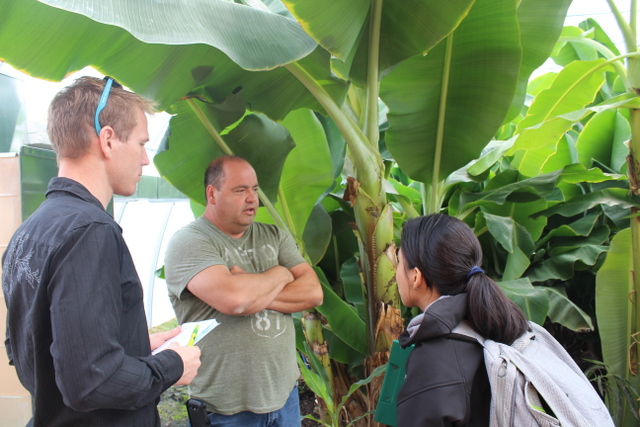Team:Waterloo/Practices/Human Practices
Human Practices
The Product
The product would be a seed with the incorporated CRISPR-cas9 construct technology incorporated in it for immunity against CaMV virus. The system would be introduced into a wild-type plant strain via an Agrobacterium transformation.
When the seed itself is harvested, it will then be screened to ensure that the new seeds have the integrated technology. The seeds would be planted and then a western blot would be performed as a diagnostic tool to detect both normal and abnormal proteins. This blotting procedure would be performed following the transfer of DNA or proteins from an electrophoresis gel. Then the seeds would be grown and exposed to the virus as well to ensure that the system is working. Safety trials will be performed in greenhouses to ensure that the newly grown plants are indeed immune to the virus. Once the safety standards have been met, the product will be made available to farmers for mass production.
End-user consultations

Canada Banana Farms is a local farm in Wingham, Ontario which grows organic, non-GMO bananas and other tropical fruits. We met with them on September 9th 2015 to get a farmer’s perspective on his needs as a potential stakeholder of our project. In addition, his stance on genetic modification of foods and its research were discussed; it was insightful to see the extent to which the role in the food industry has influenced their views.
As we concluded the visit: the farmer stated he had no issues with viruses using older farming practices, but encouraged for us to look further into applying our project to banana farming in India.
Design Criteria
-

-
Contain the CRISPR technology and therefore be disease resistant
-

-
Have higher yields with same inputs compared to available crop varieties
-

-
Be safe for consumption: The CRISPR technology should not introduce new toxins or allergens
-

-
Be palatable: Consumers who purchase harvested produce must find the taste appealing, as well as visually and textualy identical, or improved, to the original organism
-

-
Be priced competitively against current produce
-

-
Be safe for the environment
Law and Regulation
The Supreme Court of Canada has decided that specific genes and processes are patentable; however, the same is not the case for entire organisms. In other words, Canada prefers to award patents to separable components of organisms, and specific sequences of nucleic acids or proteins. In 2002, the Supreme Court of Canada denied a patent for a mouse which was modified to be oncogenic, despite it being granted in the US. Since then, the courts allow stronger patents over biotechnology, though they still do not allow patenting of whole higher level organisms.
In CRISPR
The Broad Institute was issued the US patent 8 697 359 which talks about the CRISPR-cas9 technology. After reading through the patent, we were interested to understand the scope of the statement: “Covers any engineered CRISPR-cas9 system…”. This diction appears to indicate that any modified CRISPR-cas9 system would fall under this patent and other labs that modify the system as the base pair level would not be able to patent this technology.
Pursuing project patents
We reached out to the Broad Institute to inquire about this and whether they would be interested in a joint license for our newly developed technology. However, they felt it best not to add something else to their plate due to the ongoing patent dispute between the Broad Institute and the University of California,.
No matter what the courts decide, these patents will expire in just under 20 years, after which a product such as ours will be free to produce without licensing with the Broad Institute, which currently holds the patent . After this time, it may be possible to obtain a patent in Canada for the cells which are genetically modified using CRISPR, similar to the patent rights granted Monsanto Canada in Monsanto Canada Inc v. Schmeiser. However, we would need to convince the Canadian Intellectual Property Office that our product only used the process outlined in US 8 697 359, that the product created with it is a significant improvement of the original, and contains novel DNA and/or proteins that are patentable under Canadian or American Law. We also contacted the US patent office to find out what exactly “any engineered CRISPR-cas9 system…” means, and how much of a change would be needed to justify calling it a novel and new improvement. Again however, they were unwilling to commit any answers at this point in the patenting process.
Incidentally, were a patent to be granted for the agriculturally important Cassava, we would need our patent to be protected within the largest producer of Cassava, Nigeria. Nigeria currently produces 34 million tonnes of Cassava per year, our patent would be protected in Nigeria if we obtained an International Patent as they have signed the Patent Cooperation Treaty.
In Canada, genetically modified plants are listed under the ‘Plants with Novel Traits’ (PNT) category, and their regulation is governed by the Canadian Food Inspection Agency (CFIA) . CFIA conducts a safety review of the GM crop before approving the technology for feed safety. The goal for CRISPieR, as the technology becomes industrialized, is for it’s safety to be granted unconfined environmental release; the release of the product into the environment with limited restrictions for commercialization . Currently, the regulatory approach overseeing this review only considers the final product, not the methods used to produce the PNT .
Risk analysis conducted by CFIA uses the principle of ‘Substantial Equivalence’ and ‘Familiarity’, initially developed by the Organization for Economic Co-operation and Development . Substantial equivalence compares the environmental and human health safety of the PNT to its non-modified counterpart via phenotypic comparison and compositional analysis of the GM product with it’s parent line, or a similar reference . Familiarity looks at the current knowledge of the plant species and past experiences with that species in Canada . No lonThe wide array of environmental and ecological benefits that have preceded the wide scale adoption of GM foods are indisputable. However, a large debate still surrounds the safety of the technology. This debate is not limited to general public knowledge, but extends into the data and literature as well. The GM crop industry has grown approximately 158.3 billion hectares from 1996 to 2011 . This exponential growth period, paired with the plethora of environmental variables, has resulted in a lack of long-term data that can provide unequivocal evidence in favour of GM crops. The commercialization of CRISPieR technology requires examination of safety concerns for regulatory bodies as well as the general public.
g-term testing or monitoring for PNTs is required in Canada. Technically, CFIA usually relies on data provided by corporations and not through independent testing . This implies that safety data for CRISPieR must be acquired by us.
The Plant Biosafety Office of CFIA outlines the following five (5) criteria for assessing the environmental safety of PNTs under directive 94-08: ‘Assessment Criteria for Determining Environmental Safety of Plants with Novel Traits’
- The potential of the PNT to become a weed of agriculture or be invasive of natural habitats
- The potential for gene flow to sexually compatible plants whose hybrid offspring may become more weedy or more invasive
- The potential for the PNT to become a plant pest
- The potential impact of the PNT or its gene products on non-target species, including humans
- And the potential impact on biodiversity.
Safety Concerns
To obtain approval from such organizations a step by step process is followed and therefore outlined below:
Step 1: Submitting of pre-manufacture notification
Information about the product must be submitted to the Food Directorate of Health Products and Food Branch, Health Canada. The information included in this notification has to contain:
- The name of the product and plane of manufacture
- Description of the product
- Method of manufacture
- Information about following laws and regulation of the product
- Proof that the novel food is safe for consumption
- Information of importance of product and estimated levels of consumption
- Sample of labelling of product
Step 2: Submission of a safety assessment data package
Additional information can be submitted if needed for product. It could include extensive research concerning the safety and health side effects of consumption of the product.
The information included in this assessment:
- Specific description and proof of genetic change
- Comparison of the novel food compared to non-modified version
- Potential side effects like toxins and allergic reactions
- Chemical and microbial considerations
Step 3: A minimum of 45 days is required until it is decided whether the product is safe or requires additional information by the manufacturers. If more research is required the safety assessment data package must be submitted. This process could be as lengthy as 7 years since the research involves the investigation of long-term effects as well as environmental impacts in extensive depth.
Moving beyond government regulation, the main safety concern of GM foods in the scientific community, is the unintended effects that can accompany genetic manipulation.
GM crops with insect resistant technology were a main focus following the initial commercialization of GM food products in 1996, and have more data on the their long-term effects . Specifically, an insecticidal toxin product from Bacillus thuringiensis (Bt) was transformed into cotton to yield an insect resistant genocopy . In China, the population of secondary pests has increased following the wide-scale adoption of this Bt cotton . This raises concerns as to whether the elimination of particular plant viruses would benefit competing species.
Another study reporting on Bt toxin resistance classified nine different resistant pest species in 2012 . For comparison, there was only five identified in 2010 . This proposes safety concerns in the natural arms race of plant-virus evolution. Viral resistance to the CRISPieR seeds is a variable that will need to be monitored.
Apart from these ecological issues, unexpected outcomes may also be a result of potential pleiotropic effects from the additional vector in the plant. The CRISPR-Cas9 system uses targeted nuclease activity to cleave viral DNA A main concern for its implementation would be off-target effects of the nuclease activity on the plant genome . Many studies have documented a high off-target mutation rate, attributed to the short and relaxed recognition sites the sgRNA . Previous research has shown that the 20nt target sequence in the sgRNA requires only 8-12nt at the 3’ end for site hybridization . Although advantageous for its ability to accommodate viral point mutations, it does increase difficulty for finding unique targets .
Any new sgRNAs marketed for different plant viruses will need to be tested for off-target effects . CRISPieR technology boasts secondary structural modifications that allows for easy reprograming of the sgRNA for this testing. In addition, online tools have become available for producing unique target sites . Another consideration for target site selection is the cleavage efficiency, a variable trait of the Cas9 nuclease .
The main critique for current safety assessment is the lack of consideration for these unintended effects caused by transgenic species . Upon being granted unconfined release, CRISPieR technology may wish to pursue further field-testing to appease concerns and strengthen public relations.
There are several new safety approaches that are paving a new standard for comprehensive risk assessment . These methods are delving into the biochemical output of the genome, including comparison studies of proteomes, transcriptomes, and metabolomes with cell lines subjected to natural genetic variation and conventional breeding methods .
A study conducted by Gong et al. in 2012 used a proteomic-based approach to assess the safety of transgenic modifications in rice, a widely adopted technology. The study compared the proteomic differences between two breeds of GM rice, their respective controls, and a parental line . The results were conclusive in finding that the protein profile of GM rice had minimal differences to its control in comparison with the parental lines and other GM breeds . Other studies have used a similar approach to analyze wheat, tomato, potato, and maize GM lines, with similar results of multiple parent lines and cultivars having greater variation then their respective GM counterparts . One study documented an unexpected overexpression of two transcription factors in GM tomatoes, which might not have been found using traditional comparative methods .
These studies, collectively termed as ‘omic’ studies, amass data on GM species by measuring more analytes . It has been credited for providing a comprehensive approach that shares no bias for the targeted testing used in analytical chemistry . This being said, these studies have significant differences in experimental design and data interpretation is difficult. They have ways to go before becoming the standard in risk assessment .
The CRISPieR seeds have an additional plasmid carrying the repurposed CRISPR system. The plant genome remains unedited. The question for further short-term safety studies is whether the plasmid insert will have any adverse effects on the natural biological processes of the plant. Omic studies could be the first step in drawing data for this query. Short-term studies will be used to prove that nothing in the CRISPieR technology is inherently unsafe, a claim required for unconfined release where CRISPieR will be marketable until proven unsafe .